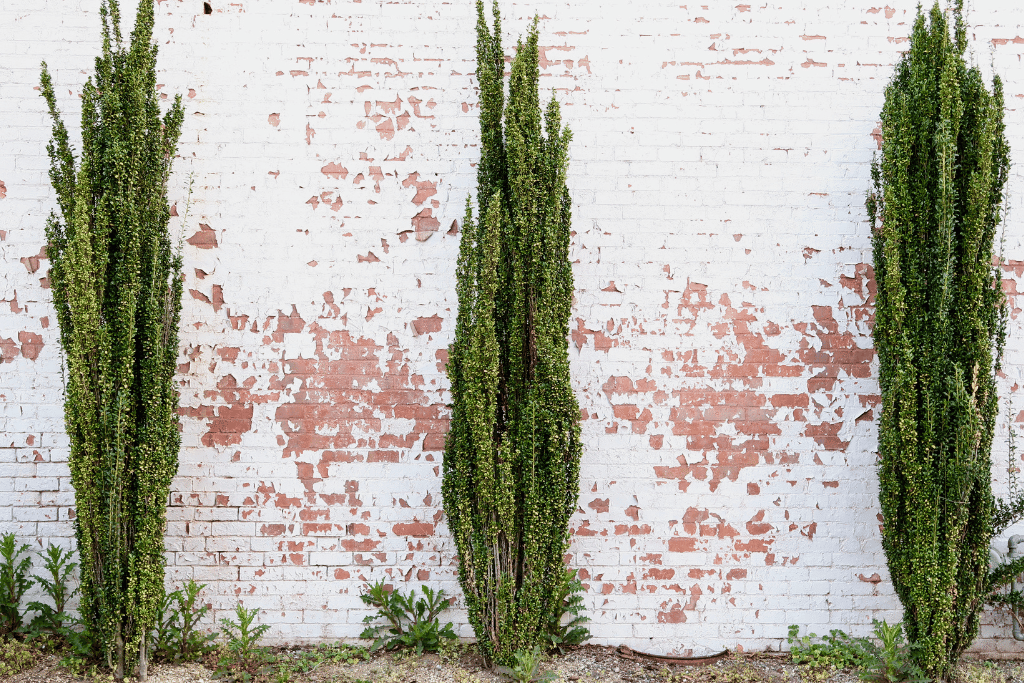
I have had the misfortune of dealing with weeds with small yellow flowers in my lawn, and I can attest to how quickly they can wreak havoc on your carefully tended garden. Not only do these pesky invaders take over quickly, but they also leave a lasting damage that is difficult to undo.
To help you out, I will share my knowledge about dealing with these weeds and provide detailed advice on recognizing them, removing them, and preventing their spread.
When you’re done reading the article, you’ll be equipped with the knowledge on how to save your lawn from weeds with small yellow flowers. So, let’s begin:
Weeds With Yellow Flowers: Spotting Them and Understanding the Damage They Can do
| Weed Name | Appearance | Damage it Can Do |
| 1. Bird’s Foot Trefoil | Yellow pea-like flowers, oblanceolate leaves | Overcrowding, choking out other plants |
| 2. Black-Eyed Susan | Yellow flowers with black discs, lanceolate foliage | Overcrowding, disrupting lawn appearance |
| 3. Black Medic | Clover-like flowers, trifoliate oval leaves | Competitive growth, barren patches in lawn |
| 4. Butterweed | Yellow/Orange discs, lobed leaves | Aggressive spread, toxic to horses and cattle |
| 5. Canada Goldenrod | Bushy, lanceolate leaves | Rapid spread, overcrowding, reduced aesthetics |
| 6. Common Evening Primrose | Yellow bell-shaped flowers, lanceolate leaves | Self-seeding, rhizome spreading, disruption |
| 7. Common Ragwort | Yellow flowers, lobed foliage | Prolific seed production, toxic to animals |
| 8. Common St. John’s-Wort | Yellow star-like flowers, oblong leaves | Rapid proliferation, skin lesions in animals |
| 9. Creeping Buttercup | Yellow cup-shaped flowers, serrated leaves | Spreading through seeds and stolons |
| 10. Creeping Cinquefoil | Heart-shaped yellow flowers, oblong leaves | Invasive, disruptive growth |
| 11. Dandelion | Yellow flowers, spear-shaped leaves | Clumps, unsightly appearance |
| 12. Garden Loosestrife | Golden-yellow cup-shaped flowers, lanceolate leaves | Rhizome spread, invasive tendencies |
| 13. Golden Clover | Oval flower head, elliptic leaves | Rapid spread, disruption of lawn aesthetics |
| 14. Grass-Leaved Goldenrod | Disc-shaped flowers, grass-like leaves | Aggressive rhizome spread, disruption |
| 15. Lesser Celandine | Star-shaped blooms, lotus-like leaves | Rapid propagation, competition with other plants |
| 16. Marsh Yellowcress | Clusters of Four-Petal Blossoms and Lobed Foliage | Disrupts lawn balance and health, invades local ecosystems. |
| 17. Purslane | Tiny Flower Heads and Fleshy Foliage | Inhibits native plant growth, reduces biodiversity. |
| 18. Skeletonweed | Strap-Shaped Flowers and Sparse Foliage | Rapid infestation jeopardizes lawn health. |
| 19. Sow Thistle | Dandelion-Like Flowers and Toothed Leaves | Crowds out other desirable plants, threatens diversity. |
| 20. Spanish Broom | Bright yellow flowers | Disrupts local ecosystems, harmful if ingested. |
| 21. Wild Parsnip | Umbrella-like flower head | Rapid seed spread, sunburn risk. |
| 22. Wild Radish | Oval Petals, Toothed Leaves | Hinders native plants, poisonous to horses. |
| 23. Wintercress | Compound flower head like a yellow rocket | Rapid seed production, potentially aggressive. |
| 24. Yellow Hawkweed | Dandelion-Like Appearance | Vigorous spread, competes with desirable plants. |
| 25. Yellow Lantana | Hydrangea-Like Flower Heads | Benign, unlikely to impact the lawn negatively. |
| 26. Yellow Nutsedge | Grass-Like Appearance with Thicker Blades | Difficult to control, rapid proliferation. |
| 27. Yellow Salsify (Oxalis) | Small Stature with Heart-Shaped Blossoms | Rapid spread but not a significant threat. |
| 28. Yellow Toadflax | Creamy and Yellow Bottle-Brush-Like Blossoms | Aggressive growth, forms patches. |
1. Bird’s Foot Trefoil
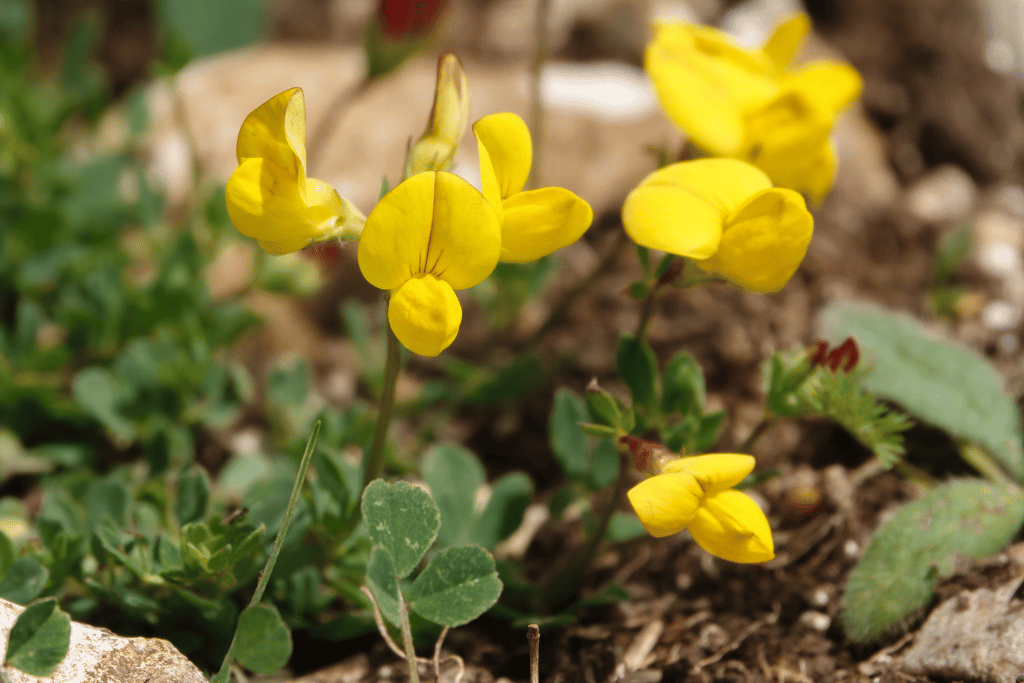
Appearance: Oblanceolate leaves
I’m sure you have seen the bright yellow flowers with oblanceolate leaves of the Bird’s Foot Trefoil. While they may look inviting, these weeds can quickly overtake a lawn and choke out other plants if ignored.
Bird’s Foot Trefoil is a deceptive weed. While its yellow pea-like flowers may seem attractive in certain settings, they are far from welcome in a well-kept lawn. The plant’s foliage features oblanceolate leaves with mostly smooth edges. This low-growing menace reaches a height of 1-2 feet.
Growth Habit
What makes Bird’s Foot Trefoil particularly troublesome is its ability to self-seed and spread through rhizomes and stolons. This invasive nature makes it a real threat to lawns across North America, as it can rapidly choke out grass and other desirable plants. Therefore, removing it from your lawn should be a top priority.
Damage it Can Do
Bird’s Foot Trefoil’s aggressive growth can lead to the overcrowding of your yard, hampering the growth of other plants and disrupting the visual harmony of your lawn.
How to Remove it from the Lawn
The best way to control Bird’s Foot Trefoil is to remove the flower heads before they can produce seeds. If you need a more thorough approach, then it’s important to get rid of the entire plant, including its rhizomes. Even the smallest fragment left behind can give rise to new plants, thus extending the problem.
Preventive Measures
Prevention is often the best strategy when dealing with Bird’s Foot Trefoil. Proper lawn care, encompassing regular mowing, appropriate fertilization, and consistent irrigation, can create an environment where this weed struggles to thrive. A healthy, well-maintained lawn will naturally outcompete Bird’s Foot Trefoil, inhibiting its growth. However, in cases where prevention falls short, consider the application of weed killers with dicamba, MCPP, and 2,4-D to effectively eradicate this persistent intruder.
2. Black-Eyed Susan

Appearance: Yellow flowers with black discs
Black-Eyed Susan can reach anywhere from 1-3 feet tall to 4-6 feet depending on the variety. These yellow flowers with black discs at their centers, are surrounded by narrow, lanceolate or ovate foliage.
Growth Habit
Although it is not an invasive species, Black-Eyed Susan has a tendency to grow aggressively and can disrupt the order of your lawn.
Damage it Can Do
If left unchecked, this weed’s vigorous growth can quickly lead to overcrowding and its towering stature may even overshadow the carefully maintained look of your lawn.
How to Remove it from the Lawn
One natural way to curtail its spread is to remove the flower heads before they mature and produce seeds. To ensure a more effective and thorough removal, you must uproot the entire plant and take out all of its rhizomes. Even the smallest fragment left behind can result in new plants.
Preventive Measures
As with many lawn invaders, prevention is key when it comes to Black-Eyed Susan. Regularly removing the flower heads before they produce seeds can significantly curtail its ability to spread. Additionally, vigilance in eliminating the entire plant and its root system, should it establish itself in your lawn, is crucial. This proactive approach can help maintain the pristine beauty of your lawn.
3. Black Medic

Appearance: Trifoliate oval shaped leaves
Flower heads resembling those of clover, along with trifoliate oval shaped leaves, are the tell-tale signs of Black Medic weed. Its annual or short-lived perennial life cycle results in a small plant, usually no more than 1-2 feet high.
Growth Habit
Black Medics possess a deep taproot that gives them an advantage over the common lawn grasses. This root system can also hinder the germination of grass seeds, creating barren patches in your lawn.
Damage it Can Do
As an invasive species, Black Medics exhibit aggressive growth patterns that can have a serious impact on the health of your lawn.
How to Remove it from the Lawn
Unfortunately, manual removal is not very effective due to the deep taproots of mature plants. Applying post-emergent herbicides containing dicamba, MCPP, and fluroxypyr is a more successful approach. Of course, prevention is the best defense against Black Medics – regular mowing and watering coupled with proper fertilization are all necessary measures to deter their spread and maintain a healthy lawn.
Preventive Measures
The best way to stop Black Medic from taking hold in your lawn is to implement preventive measures as soon as possible. Mowing, watering and fertilizing on a regular basis will discourage its growth, allowing your grass the opportunity to thrive. Additionally, avoid over-fertilization, which can make your lawn more attractive to this weed.
4. Butterweed

Appearance: Yellow/Orange discs
Butterweed’s petals, reminiscent of creamy butter in color, and its yellow or orange discs may not be entirely displeasing to the eye. This weed typically reaches a height of around 3 feet. In its youth, the leaves feature smooth edges, but as it matures, the foliage becomes more lobed.
Growth Habit
While Butterweed may not initially strike fear into the hearts of lawn enthusiasts, it harbors a dark secret. It is severely toxic to horses and cattle, and ingestion can have fatal consequences.
Damage it Can Do
Beyond its toxic nature, Butterweed can spread aggressively, quickly overtaking other plants and disturbing the pristine appearance of your lawn.
How to Remove it from the Lawn
Effective control of Butterweed involves the application of 2,4-D when the plant is in the rosette phase. In some cases, multiple applications may be necessary to achieve complete eradication.
Preventive Measures
In addition to properly filing any bare spots in the lawn, ensuring adequate fertilization and avoiding overwatering, landowners should be on the lookout for Butterweed. If spotted early enough, it can easily be pulled before it has a chance to spread.
Furthermore, if your horses or cattle are grazing in the area, frequent monitoring is highly recommended. This will help avoid any untoward health events caused by Butterweed’s toxicity. By taking measures to prevent and remove this weed, you can ensure that your lawn remains attractive and safe for all who use it.
5. Canada Goldenrod

Appearance: Bushy and lanceolate leaves
The Canada goldenrod is a pesky plant that can take over your lawn if you’re not careful. It’s characterized by its bushy flowers and lanceolate leaves, which are deep green in color and narrow at the base. The plant can grow up to 6 feet tall, but usually only reaches between 2-4 feet.
Growth Habit
The Canada goldenrod can spread quickly through its tiny, light seeds that are easily carried by the wind. It has an aggressive growth habit and competitive nature that can crowd out other plants in your lawn and reduce their aesthetic appeal.
The Damage it Can Do
The Canada goldenrod is a voracious plant that spreads rapidly through the wind by releasing its light seeds. This aggressive growth can cause overcrowding in your lawn, leading to reduced aesthetic appeal and hindering the space for desirable plants.
How to Remove it from the Lawn
If you have a young Canada goldenrod infestation, triclopyr-containing weed killers can be an effective way to deal with it. However, this herbicide may harm grass types in Florida due to warmer climate. Therefore, to avoid any issues, overseed your lawn after applying the herbicide.
Preventive Measures
The best way to deal with the Canada goldenrod is prevention. It’s important to maintain a healthy lawn and make sure weeds don’t get too much space for growth. Regularly mow your lawn and water it in dry conditions.
Moreover, it’s advisable to use mulch around plants or grasses that you want to protect from the goldenrod’s spread. Finally, you can use a pre-emergent herbicide to stop the Canada goldenrod from taking over your lawn in the first place. To make sure it works properly, take into account the type of soil and climate conditions.
6. Common Evening Primrose

Appearance: Yellow bell-shaped flowers
Common Evening Primrose possesses lemon yellow, bell-shaped flowers that follow a unique daily cycle, opening in the evening and closing during the day. The plant boasts numerous lanceolate, narrow leaves along its stem and can attain heights ranging from 2 to 6 feet.
Growth Habit
While Common Evening Primrose may not conform to the traditional image of a weed, it exhibits self-seeding tendencies and spreads with the tenacity of a true weed. Moreover, it has the capability to multiply via rhizomes, rendering simple mowing ineffective in controlling its growth.
Damage it Can Do
Its substantial size can disrupt the meticulously groomed appearance of your lawn, making it an undesirable presence.
How to Remove it from the Lawn
To effectively remove Common Evening Primrose, consider mowing it before it flowers, preventing the development of seeds and the perpetuation of its growth. For a more comprehensive approach, physically pull the plant out of the ground, ensuring the entire root system is extracted to prevent regrowth. In cases where the infestation is substantial, the application of broadleaf herbicides may be a viable option.
Preventive Measures
To keep Common Evening Primrose out of your lawn, I suggest taking proactive steps. One way to reduce the risk of it spreading is by avoiding surrounding areas with large infestations of Canada goldenrod and other flowering weeds.
These can serve as sources for this particular weed’s seeds, which can be easily transported on animal fur or clothing. Additionally, applying an herbicide after mowing can help prevent the growth or spread of this weed. Lastly, making sure your lawn is healthy and well-maintained will keep it competitive with any invading weeds.
7. Common Ragwort

Appearance: Short stems and lobed foliage
I’m sure you’ve seen it – short stems topped with numerous yellow flowers, complemented by pinnate, lobed foliage. It’s beautiful and inviting until you learn the other name for this invasive plant – “stinking willie.” Common Ragwort is a member of the Daisy family and can reach heights of 18-30 inches. Not only is it a threat to your lawn, but it also poses a danger to various animals, including cattle, horses, chickens, and pigs due to its toxic properties.
Growth Habit
Common Ragwort has a tendency to spread tens of thousands of seeds within a short span of 4-6 weeks, enabling it to propagate rapidly throughout your yard. Its invasive nature makes its presence a genuine concern – if you don’t stop it in time, it could take over your lawn!
Damage it Can Do
The prolific seed production and ability to spread quickly can lead to the rapid proliferation of Common Ragwort throughout your lawn. Furthermore, it can pose a threat to various animals due to its toxic properties.
How to Remove it from the Lawn
To prevent Common Ragwort from spreading across your lawn, mow the plant before it reaches the flowering stage. This will impair its ability to produce seeds. If the infestation is concentrated in a specific area, manually removing the plant and its root system from the ground is an effective option. Alternatively, herbicides containing MCPP or 2,4-D can be used to keep this invasive weed at bay.
Preventive Measures
The best way to prevent a Common Ragwort infestation is by regularly monitoring your lawn for any signs of its presence. If you’re unable to identify it, consider consulting an expert who can help you identify and remove the weed before it has a chance to spread further. Additionally, regular mowing and fertilizing your lawn is essential for helping prevent any weeds from taking root in the first place.
8. Common St. John’s-Wort

Appearance: Yellow stars
Common St. John’s-Wort features flowers that bear a striking resemblance to yellow stars, particularly when one observes its numerous stamens, which resemble radiant light rays. The plant boasts narrow, oblong leaves that are smooth to the touch. It can attain impressive heights of up to 6 feet and a width spanning between 3-6 feet.
Growth Habit
This species is proficient in multiplying through rhizomes and seeds, capable of producing up to a staggering 34,000 seeds annually. Such reproductive vigor enables it to invade significant areas and adversely impact various animals, leading to skin lesions, dead tissue, and other health issues.
Damage it Can Do
The rapid proliferation of Common St. John’s-Wort can result in an expansive invasion, posing a threat to your lawn’s vitality and overall health.
How to Remove it from the Lawn
To combat Common St. John’s-Wort, it is crucial to maintain a healthy lawn that creates an environment conducive to the growth of grasses, thus inhibiting the weed’s development. Consistent practices such as regular mowing, appropriate fertilization, and consistent watering can help achieve this. In cases where only a few plants are present, manual removal is a viable option.
However, for larger infestations, herbicides containing 2,4-D or metsulfuron can be employed to effectively control its spread.
Preventive Measures
The best way to prevent weed growth is to start with a clean slate. Regularly monitor your lawn for any signs of Common St. John’s Wort and address them promptly, before they spread. Furthermore, avoiding activities such as over-fertilization will reduce the likelihood of weed germination and growth.
9. Creeping Buttercup

Appearance: Triangular Serrated Leaves
Creeping Buttercup is one of the most difficult weeds to eradicate as it can spread both through seeds and stolons. Its bright yellow cup-shaped flowers and egg-like or triangular serrated leaves make it an unpleasant sight in any lawn, reaching heights of up to 1.5 feet.
Growth Habit
Creeping Buttercup spreads through seeds and stolons, making it a formidable competitor for essential nutrients in your lawn. Its ability to target potassium can compromise the health of your lawn if left unchecked.
Damage it Can Do
If left unchecked, Creeping Buttercup can severely compromise the health of your lawn. It competes for essential nutrients such as potassium, leading to a lack of growth in the surrounding grass. Not only does this detract from the attractive appearance of your lawn, but it can also lead to long-term damage with far-reaching consequences.
How to Remove it from the Lawn
Post-emergent weed killers containing 2,4-D, MCPA and aminopyralid are effective at reducing the population of this persistent weed. It is important to take action as soon as possible for optimum results.
Preventive Measures
It is important to remain vigilant when it comes to weeds, particularly Creeping Buttercup, as this weed can quickly proliferate and cause lasting damage. Regularly check for any early signs of growth and take appropriate action if needed. This could involve mowing the lawn more frequently or applying a pre-emergent herbicide prior to the emergence of the weed.
10. Creeping Cinquefoil

Appearance: Heart-shaped yellow flowers
I noticed heart-shaped yellow petals forming the cup of Creeping Cinquefoil’s flowers. While this weed’s petals may be aesthetically pleasing, it is accompanied by oblong and toothed deep green foliage that isn’t desirable in a well-kept lawn. Fortunately, Creeping Cinquefoil does not grow higher than 6 inches, allowing grass to potentially outcompete it.
Growth Habit
Creeping Cinquefoil has an aggressive growth habit that spreads through runners which root quickly and can swiftly invade your entire yard. This plant’s invasive tendencies can stifle the growth of other plants and disrupt the balance of your yard.
Damage it Can Do
The aggressive and invasive nature of Creeping Cinquefoil can lead to the suffocation of other plants and a loss of overall lawn aesthetics if left unchecked.
How to Remove it from the Lawn
Maintaining proper lawn care practices can deter the growth of Creeping Cinquefoil. This involves regular aeration, appropriate fertilization, consistent mowing, and adequate irrigation. However, due to this weed’s deep roots, manually uprooting it from the ground entirely can be challenging. In such cases, the application of herbicides containing 2,4-D, dicamba, and similar compounds can provide effective control.
Preventive Measures
To prevent this weed from growing, I practice proper lawn care such as regular aeration, appropriate fertilization, consistent mowing, and adequate irrigation. However, in cases when preventive measures fail, it is best to opt for chemical weed control.
11. Dandelion

Appearance: Spear shaped leaves
Nobody likes waking up to a field of yellow flowers dotting their yard. With its distinctive airy circles and cheerful flower heads, the dandelion is an unwelcome sight that can quickly take over your lawn. These pesky weeds typically grow between 2 and 24 inches tall, characterized by their spear-shaped, serrated leaves.
Growth Habit
Dandelions have the unique ability to spread both by seeds and roots, making them versatile invaders. Despite their relatively short stature, their tendency to grow in clumps can detract from the overall aesthetics of your lawn.
Damage it Can Do
While dandelions may not completely overrun your grass, their rapid spread can lead to unsightly clumps, marring the clean appearance of your lawn.
How to Remove it from the Lawn
For those who are inclined to preserve dandelions for culinary purposes, such as adding their leaves to salads, selective removal may be an option. However, if you’re looking for a more complete solution to control dandelion spread, herbicides formulated to target broadleaf weeds are the way to go. Some of the most effective options include products containing active ingredients such as dicamba, 2,4-D, fluroxypyr, and more.
Preventive Measures
To avoid dandelion infestations in the first place, be sure to use herbicides for bermuda grass. You can find these at most gardening stores or online retailers. Be mindful when applying them as they can damage other plants near your lawn if used improperly.
12. Garden Loosestrife

Appearance: Golden-yellow cup shaped
Garden Loosestrife presents a captivating sight with its pyramidal flower head adorned with numerous bright or golden yellow cup-shaped flowers. What sets it apart are its lanceolate or occasionally egg-shaped leaves, usually arranged in groups of three. These plants typically reach heights of 2-3 feet and possess a bushy overall appearance.
Growth Habit
Garden Loosestrife exhibits a formidable spread through both seeds and rhizomes, with the latter being particularly influential. Its extensive rhizome system delves deep into the ground, making it a resilient and challenging weed to eliminate. Its invasive tendencies pose a significant threat to the harmony of your lawn.
Damage it Can Do
The resilient spread of Garden Loosestrife, primarily through rhizomes, can lead to a persistent and overwhelming presence in your lawn, overshadowing other desirable plants.
How to Remove it from the Lawn
When faced with a limited population of Garden Loosestrife, manual removal by pulling and digging may be feasible. However, it’s crucial to ensure the complete extraction of rhizomes, as even the smallest remnants can fuel re-growth. Alternatively, herbicides containing glyphosate, triclopyr, and imazapyr can be employed to effectively combat this invasive weed.
Preventive Measures
Being proactive is the best way to protect your lawn from future infestation of Garden Loosestrife. Adhering to a strict mowing schedule and using herbicides designed for bermuda grass will help ensure that any seeds or rhizomes in the soil are properly addressed.
13. Golden Clover

Appearance: Oval Flower Head
Golden Clover, also known as large hop clover or simply hop clover, boasts a single oval or round flower head, complemented by elliptic, oblong, or rhombic smooth leaves. These plants typically range in height from 2 to 8 inches, making them inconspicuous amidst the surrounding grass.
Growth Habit
Despite its modest size, Golden Clover can attract various pollinators, thanks to its tiny yellow flower heads. However, it is not a welcome guest in many lawns due to its rapid spread. As a non-native species, it has the potential to multiply quickly, creating a profusion of tiny yellow blooms. The Invasive Plant Atlas of the U.S. has even categorized this species as invasive.
Damage it Can Do
Golden Clover’s swift proliferation can lead to the intrusion of numerous tiny yellow flower heads across your lawn. Its invasive nature can disrupt the natural balance of your landscape.
How to Remove it from the Lawn
Preventing the spread of Golden Clover often starts with maintaining a healthy, dense, and vigorous lawn. Robust grass growth can naturally discourage the proliferation of this weed. In cases where only a few plants are present, manual removal is a viable option. However, for more extensive infestations, herbicides containing glyphosate or triclopyr can be utilized to effectively manage its spread. In many home landscapes, diligent lawn care and vigilant weeding practices may suffice, making herbicides unnecessary.
Preventive Measures
When it comes to preventing Golden Clover from taking over your lawn, maintaining the ideal growing conditions is key. Consistent mowing and watering can help promote dense turf growth. Applying a pre-emergent herbicide may also be helpful in eliminating its seeds before they have a chance to sprout.
Moreover, avoiding excessive fertilizer application will reduce potential weed invasions. Finally, encouraging and allowing for a diverse plant population can create a better balanced ecosystem in your lawn.
14. Grass-Leaved Goldenrod
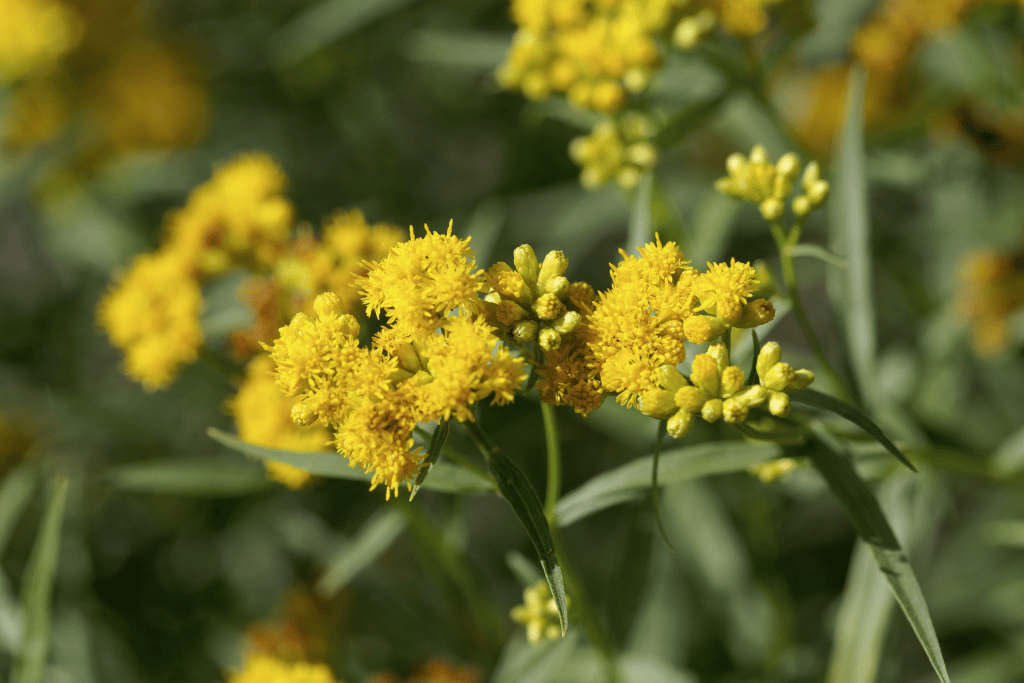
Appearance: Disced Shaped
The Grass-Leaved Goldenrod is characterized by its disc-shaped flower head, composed of numerous cylindrical flowers. True to its name, its leaves closely resemble blades of grass. However, its distinctive stem ensures it stands out amidst the lawn. These plants can reach heights of 2-3.5 feet, making them conspicuous.
Growth Habit
Grass-Leaved Goldenrod primarily spreads through rhizomes, exhibiting aggressive growth tendencies. This aggressive propagation can quickly dominate your garden, especially when exposed to ample sunlight.
Furthermore, the leaves and root system release compounds that inhibit the growth of neighboring plants, leading to a gradual decline in your lawn’s health.
Damage it Can Do
The Grass-Leaved Goldenrod’s robust rhizome-driven growth can rapidly overrun your garden, inhibiting the growth of other desirable plants and negatively affecting the appearance of your lawn.
How to Remove it from the Lawn
Efficient control of Grass-Leaved Goldenrod often involves a combination of proper lawn care practices and the application of herbicides. Herbicides containing triclopyr, dicamba, and 2,4-D are effective choices, provided they are used in accordance with package instructions. By maintaining a healthy lawn and diligently addressing weed infestations, you can keep the Grass-Leaved Goldenrod at bay and maintain the beauty of your landscape.
Preventive Measures
Promptly weeding out the Grass-Leaved Goldenrod is essential for maintaining a healthy lawn. I always esure to mow and fertilize to limit weed growth in my garden. However, don’t go overboard with the herbicides, as overuse can strip away soil nutrients and beneficial organisms.
15. Lesser Celandine

Appearance: Star-Shaped Blooms and Lotus-Like Leaves
Lesser Celandine, with its star-shaped yellow blossoms and leaves resembling a lotus, may not immediately strike you as a major concern when it stands at a relatively modest height of about a foot.
Growth Habit
This seemingly unassuming plant, however, conceals a tenacious nature. It thrives in shaded areas and nutrient-rich soil, making it a formidable adversary. What’s more, Lesser Celandine paradoxically benefits from a well-tended lawn, further complicating efforts to control it.
This weed spreads through seeds, soil disturbance, as well as the production of bulblets and tubers. It exhibits vigorous growth, invasive tendencies, and the ability to outcompete other plants in its vicinity.
Damage it Can Do
Lesser Celandine’s capacity to thrive in various conditions and rapidly propagate can lead to its domination of your lawn. It competes aggressively with other desirable plants, potentially disrupting the balance and aesthetics of your landscape.
How to Remove it from the Lawn
Given its propagation through tubers, seeds, and soil disturbance, manual weeding alone may prove ineffective unless you are willing to meticulously comb through the soil, removing even the smallest root fragments. A more practical approach involves the use of herbicides containing triclopyr and glyphosate. These herbicides are effective in managing Lesser Celandine infestations and curbing its spread.
Preventive Measures
Regular mowing and frequent weeding are crucial in preventing the spread of Lesser Celandine. Also, increasing your lawn’s fertility by enriching it with compost can help reduce the risk of this weed invading your precious turf. To prevent its growth, you should also apply herbicides containing bermudagrass-specific ingredients such as imazapyr and glyphosate, as these are proven to be the most effective in controlling Lesser Celandine. To ensure maximum efficacy, it is important to follow the instructions on the herbicide label and apply them cautiously.
16. Marsh Yellowcress

Appearance: Clusters of Four-Petal Blossoms and Lobed Foliage
Marsh Yellowcress is characterized by clusters of delicate four-petal blossoms set against lobed foliage. Typically standing at a height of no more than 2 feet, this weed blends into the landscape without drawing undue attention.
Growth Habit
Despite its unassuming appearance, Marsh Yellowcress possesses an efficient seed-based propagation strategy. It is an annual plant, with a relatively short lifespan. During its brief existence, it spreads through seeds and can invade local habitats. While it is not classified as invasive, it still poses a threat that demands attention.
Damage it Can Do
Marsh Yellowcress’s capacity to invade local ecosystems and propagate via seeds can disrupt the balance of your lawn, potentially compromising its health and visual appeal.
How to Remove it from the Lawn
Given its shallow root system, Marsh Yellowcress can be effectively addressed through manual removal by hand-pulling individual plants. Ensure that you extract the entire taproot to prevent regrowth. For more extensive infestations, you may opt for broad-spectrum broad-leaf herbicides to manage its presence.
Preventive Measures
Preventive measures include avoiding waterlogging your soil, as this can create a hospitable environment for the weed’s propagation. Apart from this, make sure that you promptly remove any weeds that appear in your lawn. Catching them early can help you nip the problem in the bud and save you from more intensive management efforts later on. With these precautionary steps, you can keep Marsh Yellowcress away for good.
17. Purslane

Appearance: Tiny Flower Heads and Fleshy Foliage
Purslane exhibits tiny flower heads containing heart-shaped petals that emerge amidst clustered, fleshy, oval foliage, particularly in the early morning. Despite its diminutive stature, reaching a height of only 3 inches, this weed can be quite resilient and insidious.
Growth Habit
Purslane’s reproductive potential is truly astonishing. A single plant can produce a staggering 240,000 seeds, each capable of remaining viable for up to 40 years. While it primarily reproduces through seeds, it can also propagate via stem fragments. This weed can disrupt your local ecosystem by inhibiting the growth of native plants, resulting in decreased pollinator activity and overall biodiversity.
Damage it Can Do
Purslane’s prolific seed production and ability to inhibit the growth of native plants can disturb the delicate balance of your ecosystem, potentially leading to reduced diversity and a less vibrant lawn.
How to Remove it from the Lawn
Preventing the establishment of Purslane in the first place is a proactive approach. You can achieve this by using clean equipment and sourcing your garden supplies from reputable sources. In the event of a Purslane infestation, consider mulching or covering it with dark plastic to obstruct its photosynthesis process.
For those who prefer a more aggressive approach, herbicides containing 2,4-D, dicamba, MCPP, and MSMA can be effective tools. However, for many home lawns, proactive prevention and non-chemical methods may suffice, rendering herbicides unnecessary.
Preventive Measures
The best way to combat Purslane is to identify the problem early on and prevent it from taking root. To do this, thoroughly inspect your lawn every spring. Additionally, be sure to maintain a healthy lawn by mowing at an appropriate height, fertilizing regularly and watering deeply. Moreover, remove any debris or organic material that may provide shelter for the weed.
Utilize a pre and post-emergent herbicide to prevent its growth and spread. Apart from that, dispose of any infected plant material or weeds that have been pulled from your garden, instead of composting them in your yard.
18. Skeletonweed

Appearance: Strap-Shaped Flowers and Sparse Foliage
Skeletonweed derives its name from the strap-shaped flowers that adorn its long, nearly leafless stems. Although slender, this weed extends extensively and can reach heights of up to 4 feet, making it an eyesore in your landscape.
Growth Habit
This weed exhibits remarkable adaptability in propagation. It can spread through various means, including seeds, root fragments, and root shoots. A mature Skeletonweed plant can produce an astonishing 20,000 seeds, earning it a reputation as invasive, particularly in the Southwest.
Damage it Can Do
Skeletonweed’s diverse propagation methods and prolific seed production can lead to a rapid infestation, jeopardizing the health and visual appeal of your lawn.
How to Remove it from the Lawn
The most effective strategy for managing Skeletonweed involves maintaining a healthy lawn and promptly removing any root fragments as soon as they are detected. For mature plants, it is advisable to mow them before they flower to prevent seed production. In cases of larger infestations, consider using weed killers containing 2,4-D, picloram, or other suitable herbicides to address the issue effectively.
Preventive Measures
Prevent it from ever taking root! Don’t let weeds accumulate, and be sure to water your lawn evenly, as this reduces the prevalence of shallow-rooted plants like Skeletonweed. Consider using a pre-emergent herbicide in the spring or early summer to protect against germinating seeds and shoot fragments. Additionally, ensure that any lawn equipment used is kept clean and free of soil and weed particles to avoid transferring them elsewhere.
In the end, if you’ve been battling weeds for a while, it may be worth investing in an aerator or overseeder to improve your lawn’s health and make it more difficult for weeds like Skeletonweed to take hold.
19. Sow Thistle

Appearance: Dandelion-Like Flowers and Toothed Leaves
Sow Thistle presents dandelion-like flowers but on a much taller scale, often reaching heights of 4 to 6 feet. Its leaves are distinctively toothed, slightly prickly to the touch, and larger compared to dandelion leaves.
Growth Habit
This weed primarily relies on wind-dispersed seeds for propagation. The good news is that these seeds have a limited viability period. However, Sow Thistle is considered invasive and poses a threat to other plants, even leading to its ban in Alaska.
Damage it Can Do
Sow Thistle’s spread via wind-borne seeds can potentially crowd out other desirable plants, threatening the diversity and overall health of your lawn.
How to Remove it from the Lawn
For those willing to employ herbicides, products containing glyphosate and paraquat can effectively address Sow Thistle infestations. If a more environmentally friendly approach is preferred, repeated manual removal can be attempted, provided that all roots are thoroughly eliminated to prevent regrowth. This method, while effective, can be labor-intensive and time-consuming, demanding strict diligence to remove the roots completely.
Preventive Measures
Preventative measures like mowing and mulching can assist in minimizing the spread of Sow Thistle, as well as other undesirable weeds. Regularly maintaining your lawn with selective weed-control products will also limit the spread of this weed and others alike. You can also opt for biodegradable silt socks that are used to block runoff from entering your lawn. This will help stop unwanted weeds from growing and further prevent the spread of existing Sow Thistle infestations.
Furthermore, using organic soil amendments can help to create a healthier environment for your desired plants. Doing so will ensure that they get all the necessary nutrients needed, while also discouraging the growth of weeds like Sow Thistle.
20. Spanish Broom
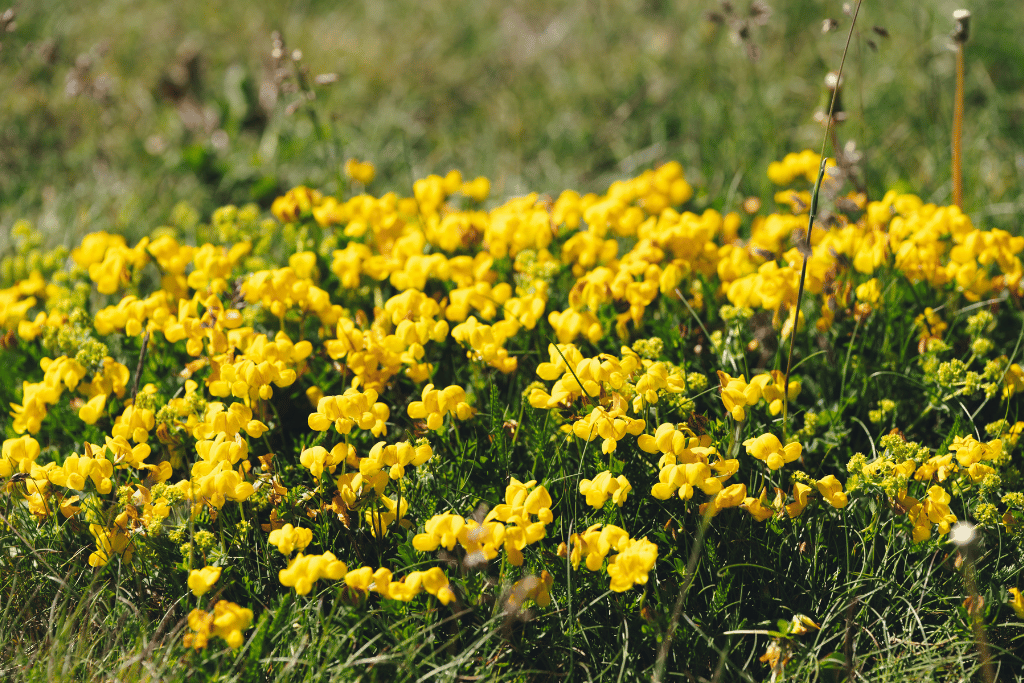
Appearance: Bright yellow flowers
The Spanish Broom may not appear overtly problematic at first glance, showcasing a bushy growth with striking bright yellow flowers. However, its integration into your landscape requires careful management.
Growth Habit
This weed primarily spreads via seeds and is classified as noxious due to its potential harm to the environment and animals. Ingestion of Spanish Broom can lead to gastrointestinal issues. Furthermore, it is regarded as an invasive species in North America, posing a threat to the local ecosystem if left to proliferate unchecked.
Damage it Can Do
Spanish Broom’s invasiveness and noxious properties can disrupt the natural balance of your environment, potentially causing harm to local fauna and flora.
How to Remove it from the Lawn
For a limited population of Spanish Broom, manual removal by pulling and digging can be effective. However, if the infestation is extensive, the most efficient approach is to employ weed killers with triclopyr and glyphosate, which are known to be effective against this stubborn weed.
Preventive Measures
Ensure that your lawn and garden beds are well-drained and free of standing water, as this weed thrives in damp conditions. Additionally, regularly trimming weeds will help keep their population controlled and limit the chances of them reproducing. Moreover, apply a thick layer of mulch, as this can prevent the growth of weeds and help reduce water evaporation from your lawn.
21. Wild Parsnip

Appearance: Umbrella-like flower head
Wild Parsnip is characterized by a compound flower head resembling an umbrella, composed of numerous tiny blossoms. Its deep green leaves are soft and toothed, taking on a mitten-like shape. This weed can reach heights ranging from 1.5 to 5 feet.
Growth Habit
Although relatively uncommon in lawns, Wild Parsnip still poses a potential threat. It can produce stray seeds that germinate and grow. This aggressive weed spreads seeds quickly, endangering existing flora. Notably, it contains a chemical that can render the skin more susceptible to sunburn, warranting caution.
Damage it Can Do
Wild Parsnip’s ability to spread seeds rapidly and its potential to induce sunburn can jeopardize your lawn’s health and pose a risk to those who come into contact with it.
How to Remove it from the Lawn
To control Wild Parsnip, consider mowing it after it has blossomed but before it sets seeds. If seeds are already present, cover the plant with a plastic bag, cut off the flower heads, and dispose of them properly.
Preventive Measures
Keeping a thick turf by watering and fertilizing regularly is important in keeping this weed at bay. Additionally, you should selectively remove any Wild Parsnip seedlings that do appear before they become established.
22. Wild Radish
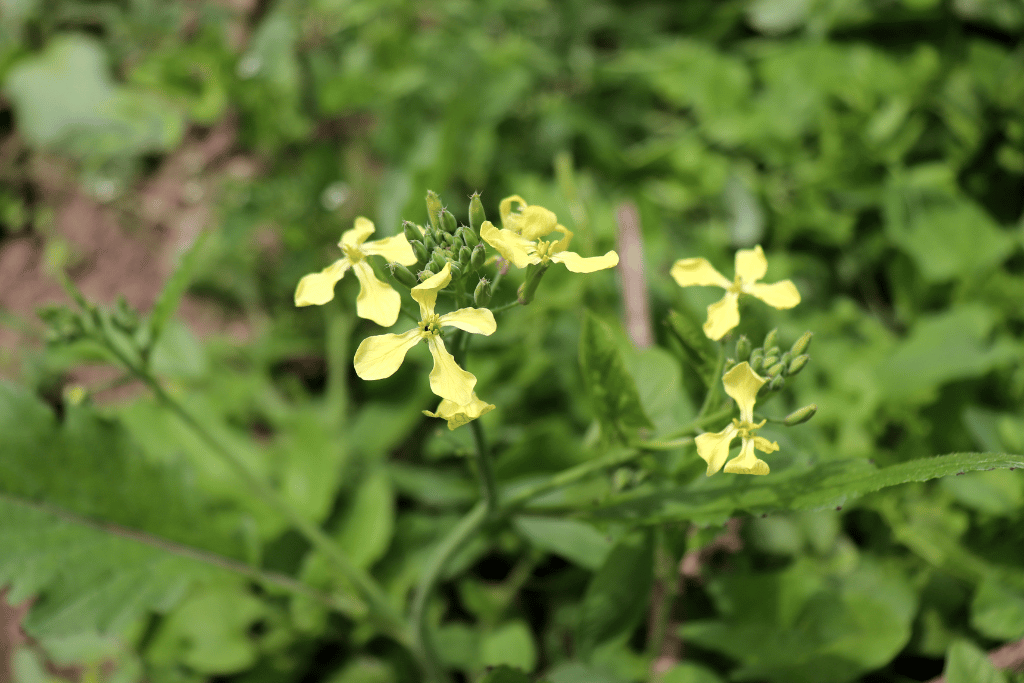
Appearance: Oval Petals, Toothed Leaves
Wild Radish features slightly oval petals in fours, barely connected to the center of the flower head. Its bottom leaves resemble eggs and possess deep lobes, while the top leaves are smaller, resembling toothed footballs and growing on short stalks.
Growth Habit
This weed is notorious for contaminating crops like wheat and hay with its seeds. As a non-native species, it can hinder the growth and development of native plants and beneficial flora. It’s worth noting that Wild Radish is considered poisonous to horses, adding to its concerns.
Damage it Can Do
Wild Radish’s potential to contaminate agricultural crops and hinder the growth of native plants makes it a troublesome weed.
How to Remove it from the Lawn
Efficient eradication of Wild Radish involves the use of herbicides. Products containing 2,4-D and dicamba are effective choices, but proper application is essential to avoid damage to your grass.
Preventive Measures
The best way to eradicate the plant in my opinion is to take preventive measures. The use of mulch and proper fertilization are great ways to avoid Wild Radish from taking root in your lawn. Additionally, regularly mowing the lawn can help cut off any weeds that have sprouted from seed or wind drift.
Another wise preventive measure is to promote native species in the area as they usually out-compete any non-native species. Native plants can be added to the lawn and provide valuable resources for beneficial insects like bees and butterflies, encouraging beneficial insects to stay in your environment. These measures will help prevent Wild Radish from taking over your yard or garden.
23. Wintercress
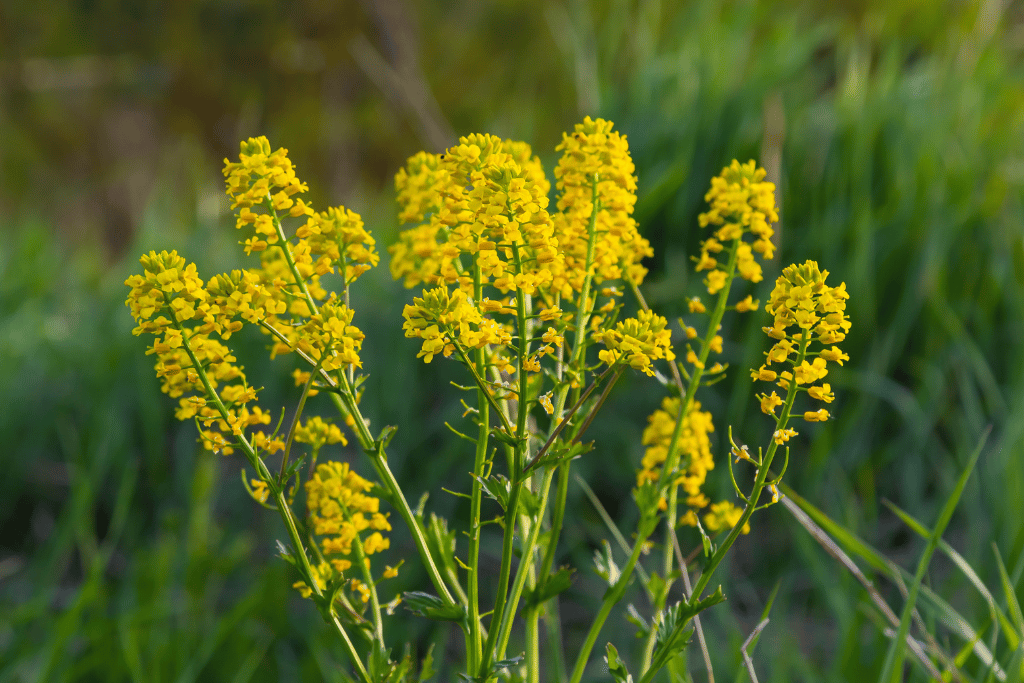
Appearance: Compound flower head like a yellow rocket
Wintercress, also known as Yellow Rocket, presents a compound flower head composed of numerous club-shaped blooms. Its leaves are oval, with rounded lobes toward their ends. Typically, the plant reaches heights between 12 and 25 inches.
Growth Habit
Wintercress has the ability to self-seed, producing up to 10,000 seeds per plant. It can exhibit invasive or at least aggressive tendencies, spreading rapidly across your lawn if not addressed in its early stages. Additionally, it is toxic to horses.
Damage it Can Do
Wintercress’s prolific seed production and potential for aggressive growth can overrun your lawn, disrupting its visual appeal and overall health.
How to Remove it from the Lawn
Mowing and removing the entire plant before it flowers is a potential strategy for managing this weed. Post-emergent, broadleaf herbicides containing 2,4-D can also be employed to effectively control Wintercress.
Preventive Measures
To avoid any issues with Wintercress, ensure that your lawn remains healthy by adhering to proper maintenance practices. Fertilizing your lawn regularly and mowing at the right height for its grass type can help discourage this weed from taking hold. Also, keeping the grass density high helps make it difficult for wintercress and other weeds to establish themselves in the lawn.
24. Yellow Hawkweed
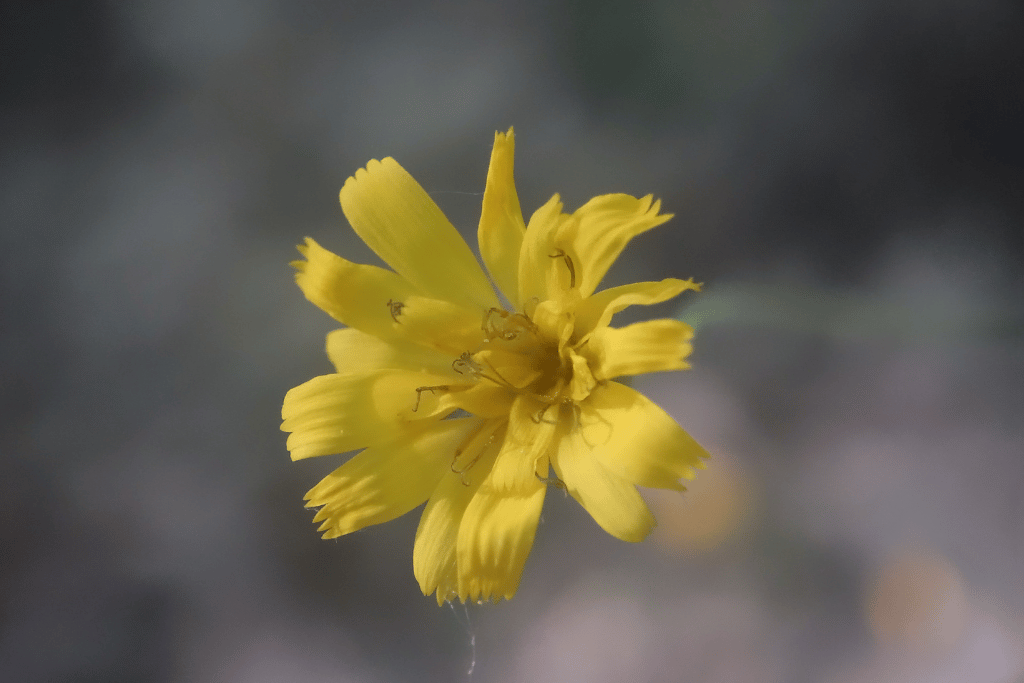
Appearance: Dandelion-Like Appearance
Yellow Hawkweed closely resembles dandelions, with stems mostly devoid of foliage. However, these stems branch toward the top and bear golden blossoms. Unlike dandelions, Yellow Hawkweed can reach heights of up to 3 feet.
Growth Habit
This species spreads by stolons, rhizomes, and seeds, making it nearly impossible to prevent its multiplication. While it exhibits some invasiveness, it is not toxic to children and pets.
Damage it Can Do
Yellow Hawkweed spreads vigorously via various means can be challenging to control and may compete with other desirable plants in your lawn.
How to Remove it from the Lawn
The most effective method for eliminating Yellow Hawkweed is to manually dig it out in the spring before it flowers and proliferates throughout your lawn. If the population is extensive, weed killers containing glyphosate can be used, but be prepared to reseed your lawn afterward.
Preventive Measures
To prevent the spread of Yellow Hawkweed, it is important to make sure your lawn remains healthy and vigorous. This can be achieved by mowing frequently at a height of 3 inches and fertilizing twice a year with a slow-release fertilizer. Additionally, regular overseeding will help maintain thatch levels in the turf so the weeds don’t have room to take root.
Moreover, keep the soil well-drained and aerated to ensure a healthy environment for your grass. This will help create a dense turf that can better compete with Yellow Hawkweed.
25. Yellow Lantana

Appearance: Hydrangea-Like Flower Heads
Yellow Lantana, despite its attractive hydrangea-like flower heads, is considered a weed. It features broad, oval leaves that grow in pairs and have a slightly toothed texture. The plant itself assumes a bushy appearance, growing up to 6 feet tall and spreading 10 feet wide.
Growth Habit
While wild Lantana can self-seed, most species are ornamental and primarily propagated through cuttings. As a result, it poses no significant threat to your lawn or other garden plants.
Damage it Can Do
Yellow Lantana is relatively benign and unlikely to negatively impact your lawn or local ecosystem.
How to Remove it From the Lawn
Rather than eradicating this species entirely, consider relocating it at least 10 feet away from your lawn or installing a border to keep it contained in one area.
Preventive Measures
If you choose to keep Yellow Lantana in the garden, be sure to avoid over-fertilizing the soil and applying too much water. Both of these practices will stimulate its growth, resulting in more frequent maintenance requirements.
Additionally, make sure that it is pruned regularly to maintain a neat appearance and prevent it from becoming unruly or crowding out other plants.
26. Yellow Nutsedge
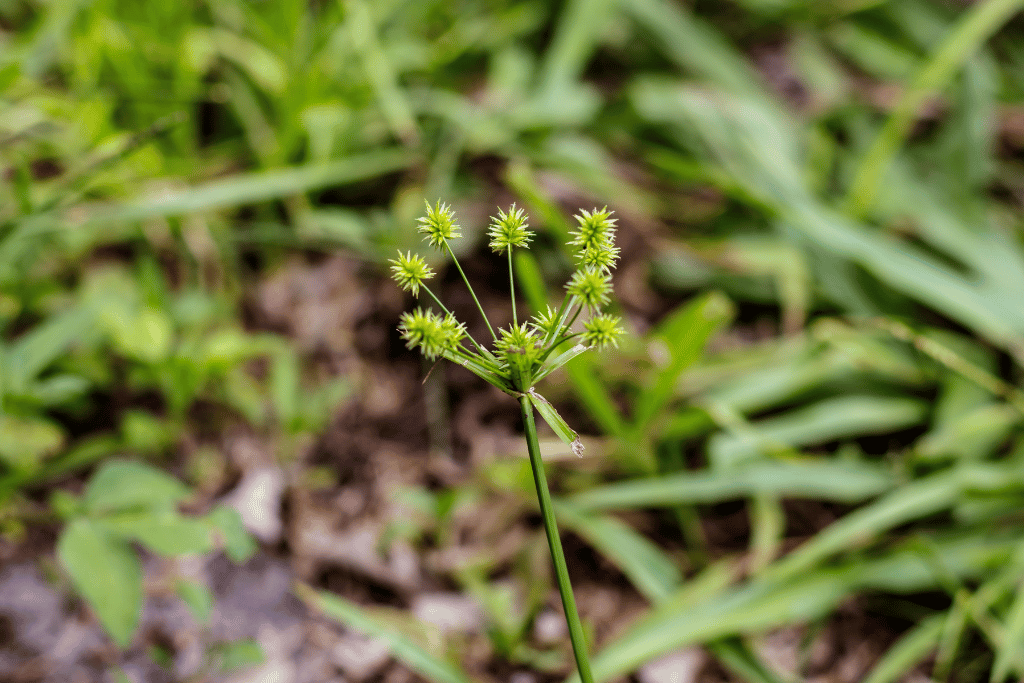
Appearance: Grass-Like Appearance with Thicker Blades
Yellow Nutsedge resembles grass but has thicker blades that stand out in contrast to the smooth texture of typical lawn grasses. It also produces flowering stalks with triangular shapes and wheat-like blossoms. This nutsedge can grow up to 3 feet tall, making it conspicuous.
Growth Habit
Yellow Nutsedge grows from tubers and can be inadvertently transferred along with soil. It also multiplies through rhizomes, which enables it to rapidly proliferate across your lawn. Although its seeds seldom germinate, it is still considered invasive.
Damage it Can Do
Yellow Nutsedge’s ability to go unnoticed for an extended period before detection makes it challenging to control. Once established, manual removal is ineffective, necessitating the use of weed killers.
How to Remove it from the Lawn
To address a Yellow Nutsedge infestation, utilize weed killers containing halosulfuron and sulfentrazone. These products are particularly effective for cool-weather grasses and can help regain control of your lawn.
Preventive Measures
Utilize proper mowing height and irrigation techniques to bolster grass health. Applying pre-emergent herbicides can also help reduce its presence in your yard.
27. Yellow Salsify (Oxalis)

Appearance: Small Stature with Heart-Shaped Blossoms
Yellow Salsify, or Oxalis, exhibits small dimensions, typically reaching heights between 3 and 8 inches, occasionally a foot. Its flowers resemble inverted hearts, and its green shamrock-like leaves don’t present a major visual concern.
Growth Habit
This weed multiplies through seeds and rhizomes, quickly spreading across your garden and lawn. Fortunately, it is not categorized as invasive, offering some relief.
Damage it Can Do
While Yellow Salsify can spread rapidly, it does not pose a significant threat to the native ecosystem.
How to Remove it from the Lawn
Maintaining a healthy lawn and addressing Yellow Salsify while it’s still young is one of the most effective strategies. When you notice the heart-shaped blossoms in your grass, manually pull the plant from the ground before it flowers, ensuring you remove the entire root system.
Preventive Measures
To prevent Yellow Salsify from taking root in your lawn, keep a regular mowing schedule and water the grass deeply on a weekly basis. This will also help to deter other undesirable weeds from encroaching upon your property. Fertilizing regularly will further assist in controlling weed growth and ensure your lawn looks its best.
28. Yellow Toadflax
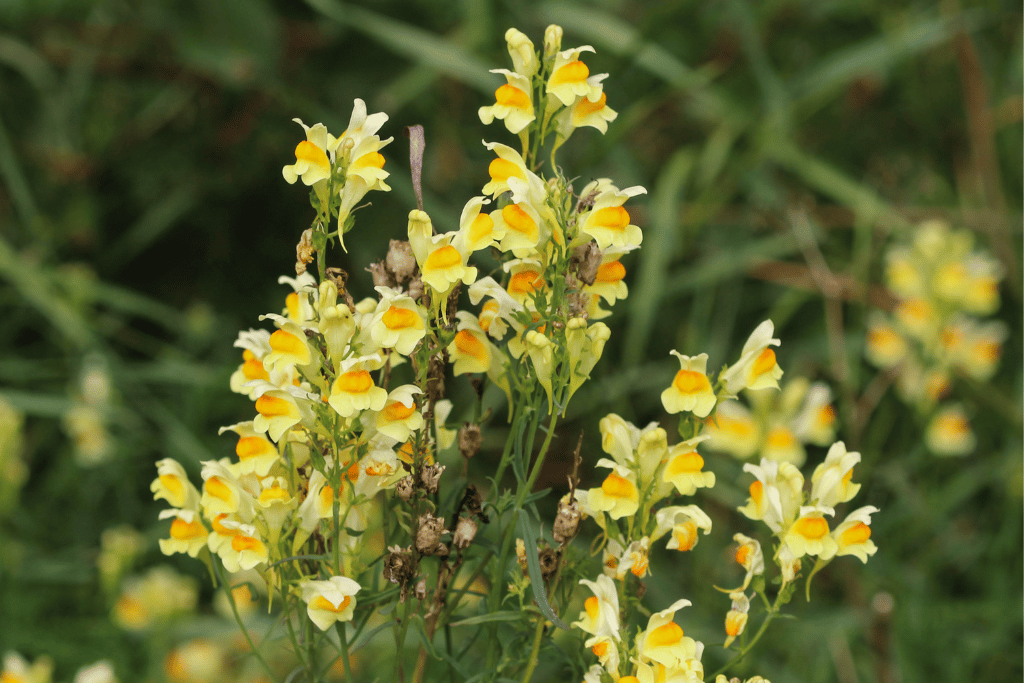
Appearance: Creamy and Yellow Bottle-Brush-Like Blossoms
Yellow Toadflax features creamy and yellow flowers that resemble snapdragon blossoms, with lanceolate, pointy, silvery-green leaves resembling grass blades. These leaves grow in pairs on stalks. Typically, the plant reaches heights between 1 and 3 feet.
Growth Habit
Similar to Yellow Salsify, Yellow Toadflax spreads through rhizomes and seeds, forming patches that disrupt your lawn’s uniformity. It is considered noxious in western states, including Colorado and New Mexico.
Damage it Can Do
Yellow Toadflax’s aggressive growth and tendency to form patches can negatively impact your lawn’s appearance and overall health.
How to Remove it from the Lawn
If you observe a few Yellow Toadflax plants flowering in your yard, consider using products with picloram or chlorsulfuron. For enhanced effectiveness, opt for a combination of picloram and diflufenzopyr to regain control of your lawn.
Preventive Measures
To prevent Yellow Toadflax from taking over your lawn, opt for a preventative herbicide treatment. Regularly mowing your lawn and removing the clippings will also help discourage its growth in your yard. If you suspect that this weed already has a foothold, it’s best to take steps to eliminate it as soon as possible.
Otherwise, it may spread to other parts of your lawn and cause more damage. Additionally, take steps to make sure the soil in your yard is well-drained and fertilized as this can help discourage its growth.
Final Words
In the battle against these weeds with small yellow flowers, it’s essential to arm yourself with knowledge about their appearance, their potential for damage, and the best methods for removal. Moreover, implementing preventive measures through proper lawn care can go a long way in maintaining the pristine beauty of your lawn.
So, take a proactive stance and employ the right strategies to keep your lawn free from these damaging intruders and enjoy the lush greenery you’ve worked so hard to achieve.


